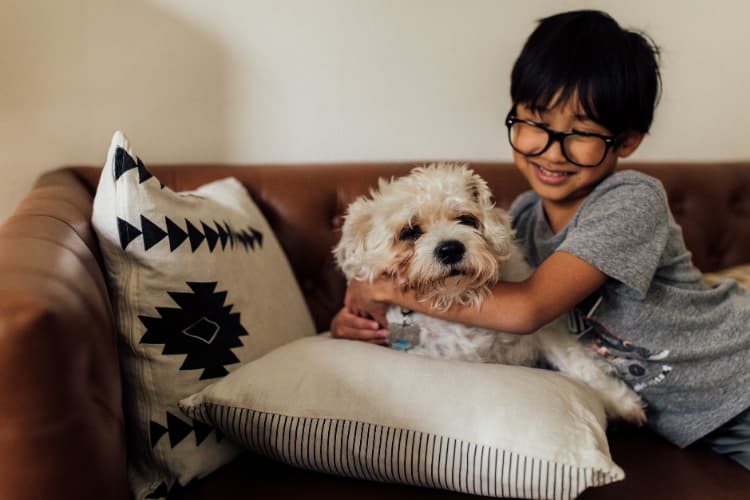We love our dog, Snickers. While she is amazing for cuddling and playing and we’re just huge fans, having a pet has many other benefits. In fact, having a pet such as a cat or a dog is a good way to teach children responsibility. If you were debating whether it is right to get a pet when you still have little children, these are reasons why you shouldn’t wait.

Teaching kids responsibility through pet care is a hands-on way to help them grow into thoughtful, capable individuals. It’s about feeding a pet or taking it for a walk, while building habits, empathy, and confidence. For families looking to raise responsible kids without spending a fortune, pet care offers daily opportunities to teach life lessons in a fun and meaningful way.
Here are eight practical ways to help your child learn responsibility through pet care.
1. Assign Age-Appropriate Feeding Duties
Feeding a pet is a simple but powerful way to teach consistency and care.
- Start with small tasks – Young children can begin by scooping dog food into a bowl or refilling the water dish. For convenient and healthy options, California Dog Kitchen offers frozen, home-cooked dog food in easy-to-serve cubes, making it easier for kids to handle feeding time safely. This introduces them to the idea of daily routines and the importance of meeting another being’s needs.
- Use a feeding chart – A visual chart can help kids track when they’ve fed the pet. This adds a sense of accomplishment and helps prevent missed meals. It also teaches accountability in a way that’s easy to follow.
- Involve them in meal prep – As kids get older, they can help prepare more complex meals, like mixing wet and dry food or adding supplements. This teaches the importance of paying attention to detail and following instructions. It also opens up conversations about nutrition and health.
2. Make Walking the Dog a Shared Routine
Walking a dog isn’t just exercise—it’s a chance to build discipline and awareness.
- Start with short walks – Begin with brief, supervised walks around the block. This helps kids learn how to handle a leash and understand the dog’s behavior. It also builds their confidence in managing responsibilities outside the home.
- Discuss safety rules – Teach kids to watch for traffic, avoid distractions, and pick up after the dog. These lessons extend beyond pet care, reinforcing general safety and cleanliness. It also instills a sense of civic responsibility.
- Set a schedule – Having a regular walking time helps children understand the importance of routine. It also gives them something to look forward to and a sense of ownership over the task. Consistency here mirrors other life responsibilities, like homework or chores.
3. Teach Grooming and Hygiene Habits
Grooming teaches kids about cleanliness and the importance of regular care.
- Start with brushing – Brushing the pet’s fur is a gentle way for kids to bond with the animal. It also helps them notice any changes in the pet’s coat or skin, teaching attentiveness. Regular brushing sessions can become a calming routine for both child and pet.
- Introduce nail trimming – While adults should handle the actual trimming, kids can learn to recognize when it’s needed. This teaches them to observe and assess situations, a skill useful in many areas of life. Discussing the reasons behind grooming tasks adds depth to their understanding.
- Emphasize cleanliness – Cleaning the pet’s bedding or toys shows kids the importance of a clean environment. It also reinforces the idea that care extends beyond the pet itself to its surroundings. This holistic approach to responsibility can translate to their personal spaces.
4. Encourage Participation in Health Care
Involving kids in a pet’s health care teaches them about wellness and preventive care.
- Attend vet visits – Bringing children to veterinary appointments helps demystify medical care. They learn to ask questions and understand the importance of regular check-ups. It also provides a platform to discuss health topics openly.
- Discuss medications – If a pet requires medication, explain the purpose and schedule to your child. This teaches them about following instructions and the importance of consistency. It also introduces them to the concept of medical responsibility.
- Monitor health signs – Teach kids to observe changes in the pet’s behavior, appetite, or energy levels. This sharpens their observational skills and encourages proactive care. It also fosters empathy and attentiveness.
5. Assign Cleaning and Maintenance Tasks
Cleaning up after a pet teaches kids about the less glamorous but necessary aspects of care.
- Litter box duty – For families with cats, scooping the litter box is a straightforward task. It teaches responsibility and the importance of maintaining a clean environment. Regular cleaning also helps prevent health issues for the pet.
- Yard cleanup – Picking up after a dog in the yard is another essential task. It reinforces the idea that responsibilities aren’t always fun but are still important. This task also teaches respect for shared spaces.
- Organizing supplies – Having kids keep track of pet supplies, like food or grooming tools, teaches organization. It also helps them anticipate needs and plan ahead. This skill is transferable to school and personal life.
6. Involve Them in Training Sessions
Training a pet can be a fun and educational experience for kids.
- Basic commands – Teaching simple commands like “sit” or “stay” helps kids understand communication and patience. It also shows them the results of consistent effort. Success in training can boost their confidence.
- Positive reinforcement – Using treats or praise to reward good behavior teaches kids about encouragement and motivation. It also helps them understand the impact of their actions on others. This concept is applicable in peer interactions as well.
- Problem-solving – When a pet doesn’t respond as expected, kids learn to adapt their approach. This fosters creativity and resilience. It also teaches that challenges can be overcome with persistence.
7. Let Them Handle Pet-Related Budgeting
Introducing kids to the financial aspects of pet care teaches money management.
- Price comparisons – Involve children in comparing prices for pet supplies. This teaches them to look for value and make informed choices. It also introduces basic math skills in a practical context.
- Budgeting for treats – Give kids a small budget to choose treats or toys for the pet. This teaches decision-making and prioritization. It also gives them a sense of autonomy.
- Saving for expenses – Encourage children to save a portion of their allowance for pet-related expenses. This instills the habit of saving and planning for future needs. It also reinforces the idea that caring for a pet is a long-term commitment.
8. Encourage Emotional Bonding and Empathy
Beyond tasks, building a strong emotional connection with a pet teaches empathy and compassion.
- Storytime with pets – Encourage kids to read to their pets. This can improve reading skills and strengthen the bond between child and animal. It also creates a calming routine.
- Recognizing emotions – Teach children to observe and interpret their pet’s body language. This enhances their ability to empathize and respond appropriately. It also improves their emotional intelligence.
- Celebrating milestones – Involve kids in celebrating the pet’s birthday or adoption day. This teaches them to appreciate and honor relationships. It also adds joy and meaning to the pet’s presence in the family.
Conclusion
By integrating these practices into daily life, children can develop a strong sense of responsibility, empathy, and independence. Pet care becomes more than a chore—it becomes a valuable part of their personal growth.




